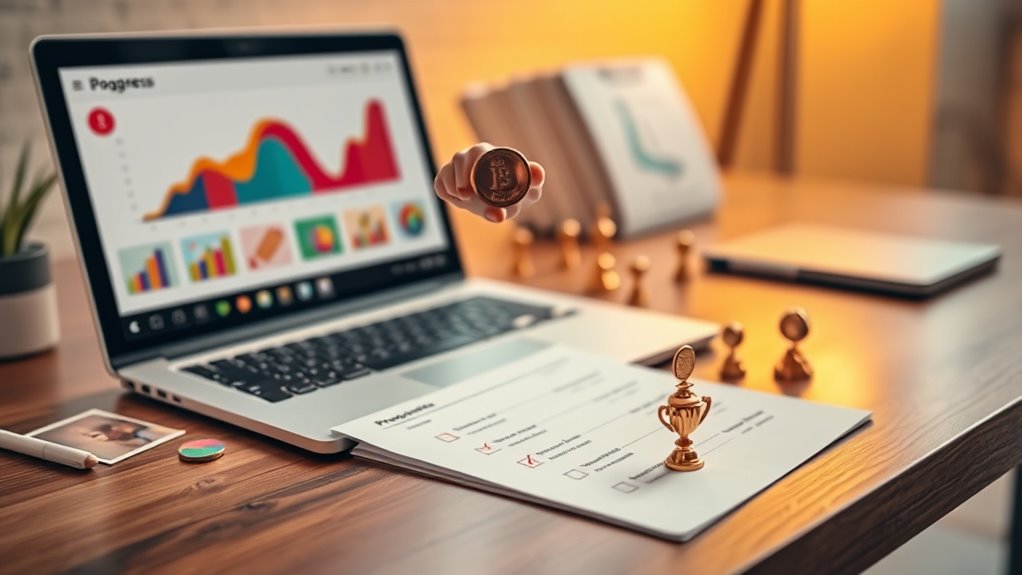Micro-rewards work by giving you quick, small wins that boost motivation and strengthen behavior through dopamine release. When you get instant feedback or celebrate tiny successes, your brain associates effort with positive feelings, making tasks more engaging. Social validation and visual progress help reinforce your habits and build confidence. While effective, it’s important to balance rewards to avoid superficial engagement. Explore more insights to harness micro-rewards for lasting motivation.
Key Takeaways
- Micro-rewards trigger dopamine release, reinforcing positive feelings and motivating repeated task engagement.
- Small achievements enhance self-efficacy and emotional resilience, encouraging persistence despite challenges.
- Immediate feedback and recognition reinforce effort, reducing goal overwhelm and maintaining focus.
- Social validation and community support boost motivation and foster habit formation around micro-rewards.
- Well-designed micro-reward systems align with intrinsic motivation, sustaining engagement without diminishing long-term interest.
The Power of Small Wins in Motivation
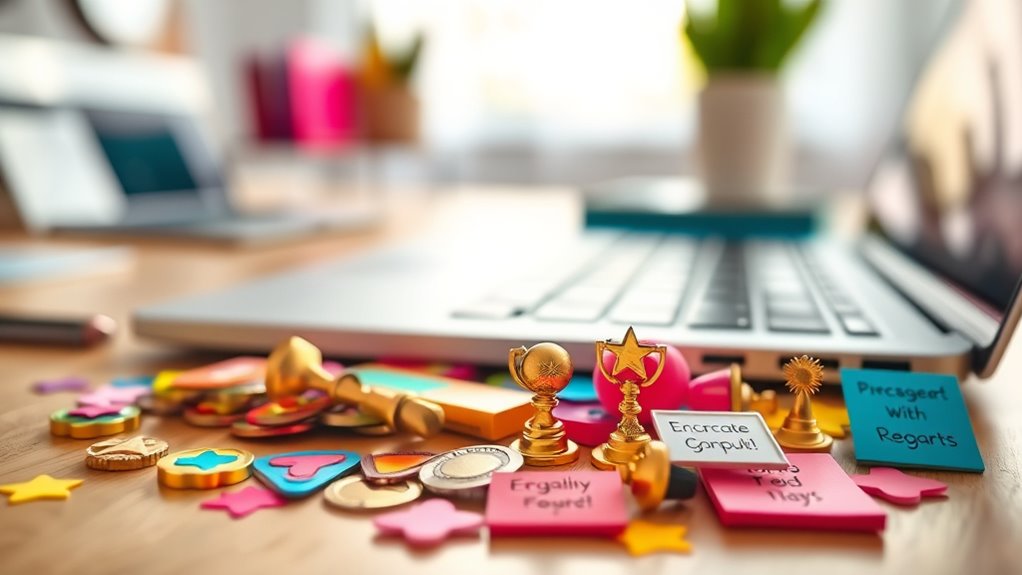
Have you ever noticed how small achievements can boost your motivation more than big, distant goals? These tiny wins strengthen your emotional resilience by providing quick, tangible proof of progress. When you celebrate small successes, you counteract cognitive biases like optimism bias, which can make larger goals seem overwhelming or unattainable. Recognizing and rewarding these micro-milestones helps you stay focused and maintain a positive mindset. They reinforce your belief that effort leads to results, making you more likely to persevere when faced with challenges. Small wins serve as constant reminders that you’re capable of improvement, fueling your motivation to keep going. Incorporating creative projects into your routine can further enhance your sense of achievement and engagement. Embracing this approach transforms your mindset, turning formidable tasks into manageable steps that build momentum over time.
How Micro-Rewards Trigger Dopamine Releases

When you receive a micro-reward, your brain quickly responds by releasing dopamine, a neurotransmitter linked to pleasure and motivation. This process activates specific neurotransmitter pathways within the reward circuitry, reinforcing your behavior. Your brain associates small achievements with positive feelings, encouraging you to repeat the task. Here’s how it works:
- Micro-rewards stimulate the reward circuitry, triggering dopamine release.
- Dopamine reinforces the connection between effort and reward.
- The neurotransmitter pathways involve areas like the nucleus accumbens and ventral tegmental area.
- This release heightens your motivation to continue working toward goals.
- Repeated micro-rewards strengthen these pathways, making task completion more gratifying over time.
The Role of Instant Feedback in Reinforcement
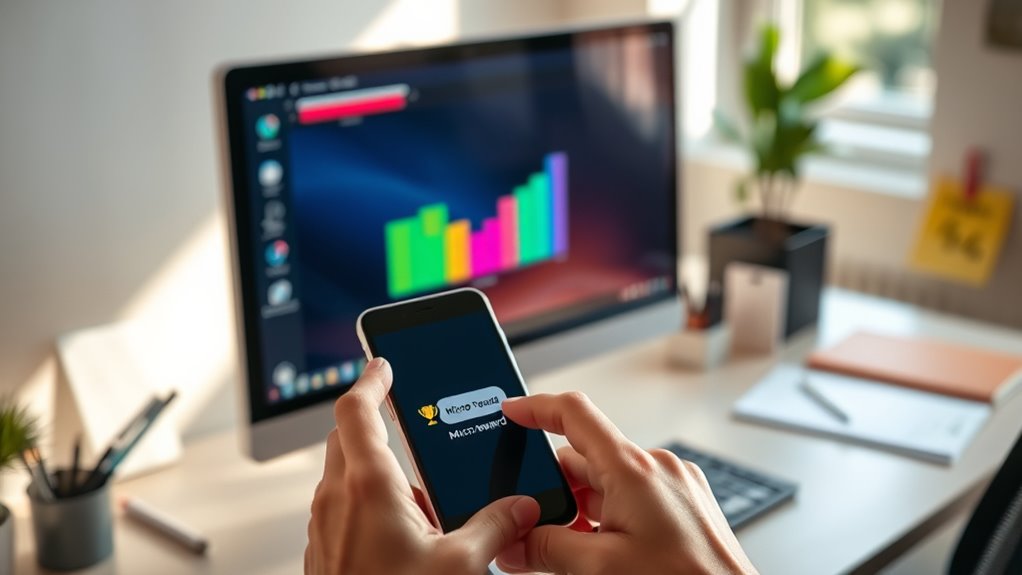
Instant feedback amplifies the effect of micro-rewards by providing immediate confirmation that your efforts are paying off. This quick response triggers positive emotional reactions, reinforcing your motivation to continue the task. When you receive instant praise or acknowledgment, your brain associates the effort with a rewarding feeling, making you more likely to repeat the behavior. Additionally, instant feedback helps counteract cognitive biases like delay discounting, where you might devalue rewards received later. By offering immediate reinforcement, you create a clear connection between your actions and positive outcomes, strengthening your sense of progress and competence. This real-time validation keeps you engaged, boosts your emotional satisfaction, and leverages your natural tendencies toward reward-seeking, making micro-rewards even more effective for task completion. Incorporating positive reinforcement techniques can further enhance this process by systematically encouraging continued effort.
Social Validation and Micro-Rewards
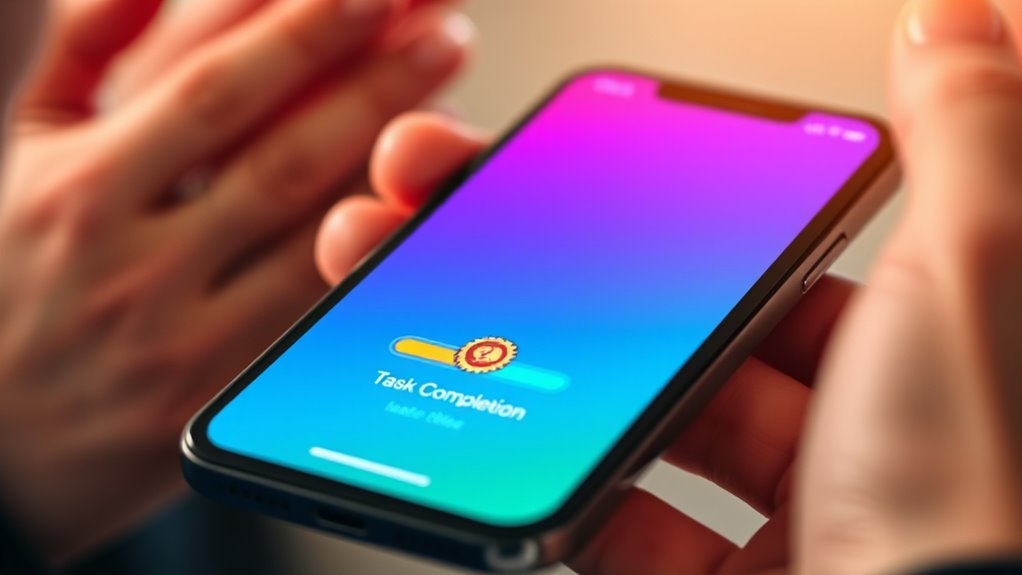
Social validation profoundly enhances the power of micro-rewards by tapping into our innate desire for connection and approval. When you receive peer recognition, it boosts your motivation and sense of belonging. Micro-rewards that are publicly shared or acknowledged encourage positive social comparison, motivating you to improve. Recognizing others’ achievements creates a cycle of validation that reinforces effort. Social validation can:
- Increase your sense of achievement through peer recognition
- Drive competition via social comparison
- Promote a supportive community atmosphere
- Encourage consistent task completion
- Strengthen bonds within a group
- Enhance trust and credibility through affiliate disclosure and transparent feedback mechanisms
Habit Formation Through Tiny Incentives

When you use tiny incentives consistently, you reinforce your behavior and start building positive routines. These small rewards keep you motivated over time without feeling overwhelming. By focusing on tiny wins, you can sustainably maintain your progress and develop lasting habits. Incorporating protective styling benefits from methods like crochet can also support your consistency by reducing stress on your hair during habit-forming routines.
Reinforcing Consistent Behavior
Reinforcing consistent behavior is essential for building lasting habits, and micro-rewards serve as effective tools to achieve this. They boost intrinsic motivation by making tasks feel more rewarding and provide emotional reinforcement that keeps you engaged. When you receive small incentives regularly, your brain associates the activity with positive feelings, encouraging repetition. To reinforce this behavior:
- Celebrate small wins to strengthen emotional reinforcement
- Use immediate rewards to create strong associations
- Focus on progress rather than perfection to sustain motivation
- Link micro-rewards to personal values for deeper intrinsic motivation
- Track your achievements to visualize consistency and build momentum
- Incorporate predictive analytics to better understand your progress and optimize your reward system.
Building Positive Routines
Building positive routines hinges on consistently reinforcing small behaviors that add up over time. To do this effectively, you need to balance intrinsic motivation with extrinsic rewards. Intrinsic motivation comes from genuine interest or satisfaction in the activity, helping you develop lasting habits. Meanwhile, micro-rewards act as extrinsic incentives, providing quick boosts that make routine tasks more appealing. By celebrating small wins through tiny incentives, you create a positive feedback loop that encourages repetition. Over time, these micro-rewards help your brain associate routine behaviors with positive feelings, strengthening the habit. The key is to make the behavior feel rewarding enough to sustain itself, so you’re motivated both internally and with small external cues that reinforce your progress. Additionally, incorporating forsale 100 strategies can encourage continued engagement and motivation.
Enhancing Motivation Sustainably
To sustain motivation over the long term, incorporating tiny incentives into your habits can make a significant difference. These small rewards help reinforce positive behaviors and promote reward sustainability. Keep in mind that cultural differences influence how micro-rewards are perceived and accepted, so tailor your approach accordingly. Consistency is key to habit formation, and tiny incentives can make routines feel achievable without burnout. To maximize effectiveness:
- Choose culturally appropriate rewards
- Vary incentives to prevent habituation
- Keep rewards immediate and simple
- Focus on intrinsic motivation alongside micro-rewards
- Track progress to reinforce habit development
- Incorporating aesthetically pleasing home decor elements into your environment can also subtly enhance motivation and create a more inviting space for habit practice.
The Impact of Visual Progress Indicators

When you see your progress visually, it can really boost your motivation to keep going. Clear indicators help you understand exactly how close you are to your goal, making it feel more achievable. This visual feedback keeps you focused and encourages consistent effort. Incorporating limited-edition artwork as a goal can make your achievements feel more special and rewarding.
Enhances Motivation Effectively
Visual progress indicators substantially boost motivation by providing immediate, tangible evidence of your achievements. They tap into cultural influences that shape how you interpret progress, making the rewards more meaningful. Your individual differences also play a role; some people find visual cues highly motivating, while others may overlook them. These indicators help maintain focus, reduce feelings of being stuck, and foster a sense of accomplishment. When you see progress accumulate, you’re more likely to stay committed and push forward. To maximize their effect, consider customizing indicators to match your preferences. Recognizing cultural and personal factors ensures these tools work effectively for everyone, boosting motivation across diverse groups. Additionally, understanding how music therapy integration and sound healing science influence emotional states can further enhance the effectiveness of motivational tools like visual progress indicators. Ultimately, visual progress indicators serve as powerful, universally applicable motivators in task completion.
Promotes Goal Clarity
By offering clear and immediate feedback on your progress, visual indicators help you understand exactly where you stand in your goals. When you see a progress bar or checklist, it clarifies your goal specificity, making the task feel more tangible. This clarity boosts your intrinsic motivation because you know what needs to be done and can see your advancement. As a result, you’re less likely to feel overwhelmed or distracted, maintaining focus on completing the task. Visual progress indicators serve as constant reminders of your achievements, encouraging continued effort. They turn abstract goals into concrete steps, helping you stay committed and motivated throughout the process. Additionally, integrating Smart Features such as auto-adjustments based on air quality readings can enhance your understanding of progress, making your goals more accessible and attainable, fueling your desire to succeed.
Micro-Rewards and Self-Determination Theory

Micro-rewards play a significant role in supporting intrinsic motivation, as explained by Self-Determination Theory (SDT). These small incentives foster a sense of autonomy enhancement, making you feel more in control of your tasks. When micro-rewards align with personal values or interests, they strengthen your intrinsic motivation to complete activities. By providing immediate feedback and recognition, micro-rewards reinforce your sense of competence, encouraging continued effort. This process boosts your engagement and satisfaction, fueling your willingness to pursue goals independently.
- Reinforce autonomy by giving choices
- Boost competence with timely feedback
- Encourage personal relevance of tasks
- Create a sense of mastery
- Sustain motivation through small wins
Limitations and Potential Drawbacks of Small Incentives
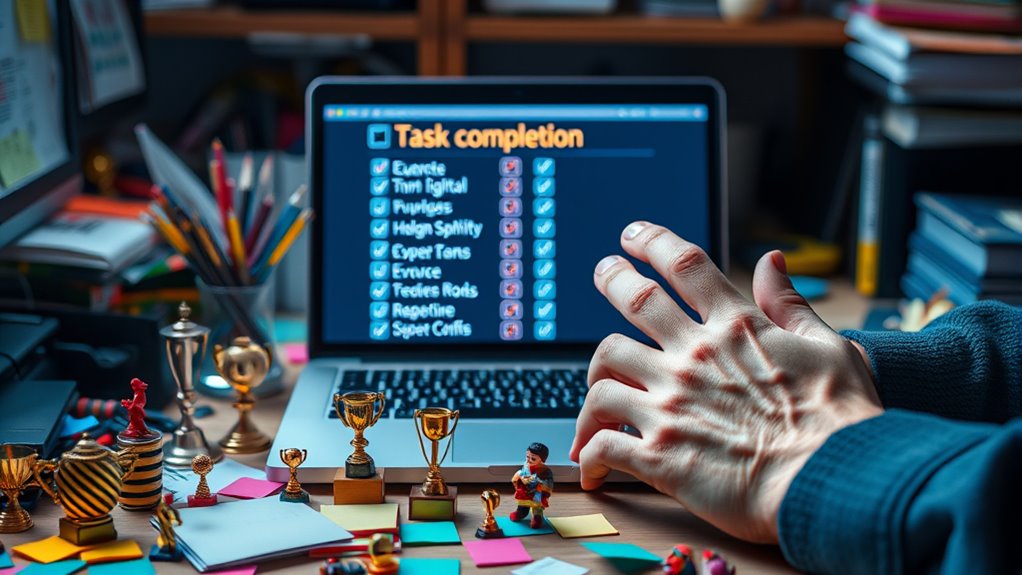
While small incentives can effectively boost motivation, they also have notable limitations that can undermine their long-term effectiveness. One key issue is the overjustification effect, where external rewards diminish intrinsic motivation over time, making tasks feel less inherently rewarding. If you rely too heavily on micro-rewards, you risk creating reward dependency, where your motivation becomes tied to continual incentives rather than genuine interest. This can lead to decreased effort once rewards are removed or reduced, ultimately harming long-term engagement. Additionally, small rewards may foster a superficial engagement, encouraging task completion solely for the incentive rather than meaningful learning or satisfaction. Recognizing these limitations helps you avoid over-relying on micro-rewards and promotes more sustainable motivation strategies.
Designing Effective Micro-Reward Systems

To design effective micro-reward systems, you need to focus on aligning incentives with genuine motivations and ensuring they promote sustainable engagement. Leveraging insights from behavioral economics helps you understand how small rewards influence behavior over time. Personalizing rewards makes them more meaningful, increasing motivation and loyalty. Keep these strategies in mind:
- Use reward personalization to cater to individual preferences
- Incorporate immediate feedback to reinforce positive behavior
- Balance extrinsic and intrinsic motivators for long-term engagement
- Design simple, attainable rewards to sustain momentum
- Continuously analyze user responses to refine your system
Frequently Asked Questions
How Do Individual Differences Affect Responses to Micro-Rewards?
Your responses to micro-rewards vary because of individual differences like personality traits and reward sensitivity. If you’re highly reward-sensitive, you might feel more motivated and energized by small rewards, making tasks feel easier. Conversely, if you have traits like low reward sensitivity, micro-rewards may not boost your motivation much. Your personality also influences how you perceive and respond to these rewards, shaping your overall engagement and performance.
Can Micro-Rewards Negatively Impact Intrinsic Motivation Over Time?
You might worry that micro-rewards could harm intrinsic motivation, especially if you become reward-dependent. When you rely too much on external rewards, your intrinsic motivation to complete tasks for their own sake could decrease over time. This shift can lead to decreased satisfaction and engagement. To avoid this, balance micro-rewards with activities that nurture your internal drive, ensuring your motivation remains strong without becoming overly dependent on external incentives.
What Are the Best Practices for Tailoring Micro-Rewards to Diverse Tasks?
Did you know personalized rewards boost motivation by 65%? When tailoring micro-rewards to diverse tasks, focus on personalization strategies that match each task’s nature and your preferences. Use reward timing to reinforce positive behavior effectively—timely rewards are more impactful. By customizing rewards and timing them appropriately, you can enhance engagement and motivation across different tasks, making your efforts more consistent and rewarding.
How Do Cultural Factors Influence Perceptions of Micro-Rewards?
You should consider that cultural norms shape how people perceive micro-rewards; some cultures value individual achievement, while others emphasize group harmony. These differences influence reward perception, affecting whether micro-rewards motivate or feel trivial. By understanding your audience’s cultural background, you can tailor your approach, ensuring that rewards resonate appropriately and effectively motivate. Recognizing these cultural nuances helps you create more meaningful and impactful reward systems.
Are There Long-Term Psychological Effects From Consistent Micro-Reward Use?
Ever wonder if micro-rewards lead to lasting psychological changes? When you use them consistently, you might develop habits that reinforce positive behavior, but beware of reward habituation, where the impact diminishes over time. This can reduce motivation and make rewards less effective. Long-term, it’s possible you could experience both increased motivation and potential dependency, highlighting the importance of varied reinforcement strategies to sustain healthy habit formation.
Conclusion
Imagine yourself climbing a staircase, each small step filled with tiny sparks of motivation lighting your way. Micro-rewards act like those sparks, fueling your progress with bursts of dopamine and a sense of achievement. When you harness instant feedback and visual cues, you turn every task into a series of mini victories. By designing thoughtful micro-reward systems, you’ll find yourself propelled forward, building momentum with each step, transforming effort into a rewarding journey.
